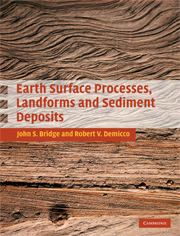Book contents
- Frontmatter
- Contents
- Acknowledgments
- Figure credits
- PART 1 Introduction
- 1 Definitions, rationale, and scope of the book
- 2 Overview of the Earth
- PART 2 Production of sediment at the Earth's surface
- PART 3 Fundamentals of fluid flow, sediment transport, erosion, and deposition
- PART 4 Environments of erosion and deposition
- PART 5 Sediment into rock: diagenesis
- PART 6 Long-term, large-scale processes: mountains and sedimentary basins
- References
- Appendix: Methods of study of Earth surface processes, landforms, and sediments
- Index
- Plate section
1 - Definitions, rationale, and scope of the book
from PART 1 - Introduction
Published online by Cambridge University Press: 05 June 2012
- Frontmatter
- Contents
- Acknowledgments
- Figure credits
- PART 1 Introduction
- 1 Definitions, rationale, and scope of the book
- 2 Overview of the Earth
- PART 2 Production of sediment at the Earth's surface
- PART 3 Fundamentals of fluid flow, sediment transport, erosion, and deposition
- PART 4 Environments of erosion and deposition
- PART 5 Sediment into rock: diagenesis
- PART 6 Long-term, large-scale processes: mountains and sedimentary basins
- References
- Appendix: Methods of study of Earth surface processes, landforms, and sediments
- Index
- Plate section
Summary
Definition of terms
Earth surface processes include weathering; sediment production by weathering and biochemical or chemical precipitation; erosion, transport, and deposition of sediment under the influence of gravity, flowing water, air, and ice; earthquakes and Earth surface motions; volcanic eruptions and movement of volcanic ejecta. Study of the landforms (morphology) of the Earth's surface, including the processes responsible for such landforms, is called geomorphology. The study of sediment, specifically the nature and origin of unconsolidated sediments and consolidated sedimentary rocks, is called sedimentology. Stratigraphy strictly means the description of (sedimentary) strata, which, by definition, is another aspect of sedimentology.
Importance of Earth surface processes
Earth surface processes are important for scientific, engineering, environmental, and economic reasons, as explained below.
Shaping of the Earth's surface
Many of the Earth surface processes responsible for landforms involve the formation, erosion, transport, and deposition of sediment (Figure 1.1). It is impossible to understand the formation of depositional landforms (such as deltas and beaches for example) without knowledge of the sediments that compose them. Furthermore, the nature of sedimentary deposits is likely to be related to the processes of sediment production and erosion in the source area. Therefore, the disciplines of geomorphology and sedimentology are intimately related.
Interpretation of ancient surface processes, landforms, and sedimentary deposits
The only rational way of interpreting the origin of ancient sedimentary deposits (Figure 1.2) is to compare them with modern sedimentary deposits, or with theoretical models based on knowledge of modern sedimentary processes.
- Type
- Chapter
- Information
- Publisher: Cambridge University PressPrint publication year: 2008
- 1
- Cited by



